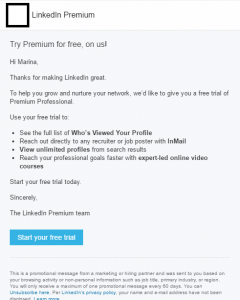For some of us, extracting intelligence from “big data” has been a practice for decades or more. We simply didn’t have a convenient buzzy term for it.
What hasn’t changed over that time is the necessity to extract meaningful, actionable intelligence and apply it to grow a business.
Factoring each business’s unique environment, opportunities, competition, resources, limits, etc. are all necessary in order to make the most of intelligence derived from data. One size does not fit every situation.
Quite necessarily, we cannot be seduced by the easy answer that counting clicks or tracking response rates is a measure of the ultimate results we intended to drive.
A CMO recently ask me about my cost to acquire (CTA). I was taken aback as my business is not comparable to his in any way. He had no context with which to judge an answer (ultimately not offered). Whatever my answer (“6!”), he had no way of assessing it to conclude that I am either a marvel or a hack.
I reached a conclusion instead: He simply wasn’t ready to manage his business with data of any size.
Same Data, Wildly Different Results
I’ll draw an example from over a decade ago. I worked with a telecommunications company that captured data for every call—its source, type, time, duration, destination, switching routes, costs, etc. We had data for every call to and from every business across the country. It should come as no surprise that this generated big data.
From this data, the client conducted analysis and created a customer segmentation strategy. It looked like this:

In theory, the customer segmentation strategy was a great idea: treat customers differently and ideally, appropriately.
But the thinking that defined this strategy and its application was flawed:
- The segmentation was inwardly focused on what exclusively mattered to the company: revenue.
- It doubled-down on that flaw by weighting projected future revenue as the only other segmentation input.
- In executing against the segmentation, the client marketed exclusively to customers in Segment 1. Said differently, a customer had to earn, through current and expected spend, the indulgence of marketing.
- By ignoring all other segments, it was assumed that they had no current or future value.
- By ignoring all other segments, it was assumed that nothing will change—even through intelligent, targeted, relevant marketing.
As a customer-centric marketer, I took the same marvelous big dataset and created a customer-centric segmentation strategy. The underlying analysis and resulting intelligence was far more complex, far more insightful, far more actionable—and far more valuable.
Suddenly, we knew what to market to whom and when.
The larger point is that the same big dataset in the wrong hands led to anemic—and even destructive— results.
In the hands that also held goals and customer perspective, the same big dataset, now applied with specific objectives (“let’s speak directly to need to acquire, keep, and grow our customers!”), an understanding of the data, relevant business parameters, and most importantly with critical thinking, changed the business model given the resulting success.
The company became outward- and customer-focused. Rather than exploit or neglect, it engaged. And my client enjoyed the big return earned from applied intelligence.
I intentionally used an aged example because an even greater challenge exists today. Given the availability of data and its immediacy, variety, and velocity, we are tasked with creating and applying intelligence in the customers’ time, not at our convenience.
Technology captures the moment of customer interest, and we must be poised to seize and optimize it. We now have the opportunity to get it right—or wrong—much, much faster. With that, we necessarily must be alert, critical thinkers, prepared to extract and apply meaning to effectively grow business.
Instead, we are too often distracted by easy, empty, and superficial answers: count the clicks, check the response rate, compare CTA. Without context or application, those are just aimless numbers.
Data Done Wrong and Where it Hurts
We simply cannot—and must not—put data into the wrong hands. The earlier segmentation example is one of data done wrong: all the underlying analysis was correct, but it did not support the objective, and its marketing application had, for a time, a very corrosive effect on the customer base.
Here are a few more recent examples of data entrusted to those who are not ready:
- Facebook’s algorithm picked up and promoted as trending a false story about Fox News reporter Megyn Kelly. Having recently removed the critical-thinking team that assessed the validity and substance of their reports, Facebook instead relied on machines and their algorithm to select content.
There is flawed thinking in the use of data in this example: volume = truth.
Rather than maintaining critical (and clearly necessary) thinkers to the process, Facebook assumed that its machines have judgement, and can assess and consider.
But all they did was aggregate.
What they had to do was think.
- A retail client gleefully announced in a company meeting that the introduction of a super-sized staple product was wildly successful.The client also casually mentioned that the larger size product contributed to a reduction in the number of retail trips by 3 per customer annually.He failed to see that disaster loomed because he hadn’t thought critically. Even without doing the math (which told a grim story), the loss of the average spend / retail trip for customers in the tens of millions multiplied by 3 was staggering. Because the significance, or even simple multiplication, had not been applied, the near- and long-term impact of the change in product size was not understood. He was blind to that impact because he assessed adoption myopically.He should have applied full and considered context. (And he should have done the math.)
- I recently received an offer for a free trial of LinkedIn Premium. Why do I mention it? I am a LinkedIn Premium member.
 The small type describes the data our friends used to select me for their generous offer. Clearly, they failed to apply the most relevant data point in selection criteria: current membership status.
The small type describes the data our friends used to select me for their generous offer. Clearly, they failed to apply the most relevant data point in selection criteria: current membership status.
(As an aside, I would have forgiven this as an error in selection, but I received this offer twice over a few weeks.)
This mistargeted offer may seem harmless. In my case, it sent me looking at my statements and at my status to confirm my understanding. Maybe it took 10 minutes, but all of those minutes were unnecessarily wasted by LinkedIn. Those minutes were spent in a state of irritation. Memorable irritation.
I am certain that is not the impression LinkedIn intended when they sent the offer through messenger, then forwarded it through email, and then sent it again.
LinkedIn applied some algorithm intended to project adoption.
They failed to select data based on their objectives.
There is an additional point specific to these examples: none occurred in real time. They were the result of passive interaction with data, an absence of true consideration, and poor decision-making. That makes them all the more unforgiveable.
Big Data Readiness: Are We There Yet?
Returning to the original point of this piece: Are We Ready for Big Data?
My lukewarm answer is: “It depends.”
In the wrong hands—applying an ill-conceived approach, poor analysis, shoddy intelligence, or surrendering to the siren song of the easy answer—big data will harm a business, often irreparably.
Being ready for big data is not the result of a moment’s preparation, of reacting to a detached metric, or from trifling interaction. It cannot be learned in an afternoon seminar.
Just as iron sharpens iron, being ready requires training, expertise, prolonged exercise, understanding of the best practices generally, and individual business specifically.
Being ready for big data requires data and analytic intelligence, too.
There is no question that this sounds like a high price to be ready to gain optimal value from big data. It should be. Consider the results and the return from engaging customers in the moment opportunity is recognized, delivering a compelling message that propels the marketing and sales cycle, and increasing revenue—predictably.
That is what we must be ready for.
Would you like to discuss customer intelligence? Measurable strategy? Or how to meet revenue goals? Let’s talk! Set up a 30-minute phone conversation with Marina.
Photo Credit: Jennifer Burk

